Aftercare
We manufacture products to be worn for years to come. We advocate the best possible care for your product to reduce waste and therefore have less of an impact on the environment.
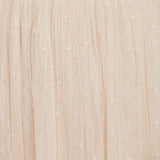
TULLE, EMBELLISHMENT & EMBROIDERY
Tulle is our core fabric at Needle & Thread and is used to make our signature embellished, embroidered and textures styles. We have developed our tulle qualities in recycled polyester which is certified under the Global Recycle Standard (GRS). Our embellished and embroidered artworks are delicately hand-drawn and we use a range of specially selected sequin and thread colours to create our signature styles. Each size in the collection (UK 4-24) has a tailored artwork so every size feels special. Over 90% of our sequins are made from recycled plastic using self-generated waste. Our sequins are certified under the Global Recycle Standard (GRS).
TULLE, EMBELLISHMENT & EMBROIDERY

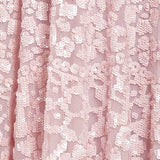
EMBELLISHMENT - SEQUINS
Our artworks are delicately hand-drawn and embellished using a range of specially selected sequin colours to create our signature styles. Over 90% of our sequins are made from recycled plastic using self-generated waste. Our sequins are certified under the Recycle Claim Standard (RCS).
All of our carefully selected sequins are stitched to the tulle fabric using special needles that loop the sequins together to create each motif. Threads are knotted frequently within each motif to ensure that the sequins are secure. Our sequins are selected and dyed in colours signature to Needle & Thread. As these garments are made by hand, they can be very delicate and need to be handled with care. We recommend taking extra care with jewellery when dressing. This helps to prevent the threads of the sequins getting caught and potentially coming loose.

EMBROIDERY - THREAD WORK
Our artworks are delicately hand drawn and embroidered using a range of bespoke thread colours to create our signature style. Each size in the collection (UK 4-24) has a tailored artwork so every size feels special.
Our embroidery is created by loops of carefully selected colourful threads. Due to the delicate nature of the threads, we recommend taking extra care with jewellery when dressing. This helps to prevent the threads of the embroidery getting caught and potentially coming loose.
HOW TO ALTER YOUR TULLE PRODUCT
Our hems are left raw cut and can be altered easily if the length of your dress needs to be amended. If your style has an unembellished or embroidered skirt, the hem can be cut neatly with sharp scissors by an experienced seamstress or tailor. The hem of our crepe de chine lining can be altered easily and finished with a simple pin hem.
HOW TO ALTER YOUR EMBELLISHED OR EMBROIDERED PRODUCT
We have a few different ways of creating our embellished or embroidered designs. Some of our styles are more suitable for alterations than others. Please contact our customer care team if you require information on any specific styles by emailing customercareme@needleandthread.com
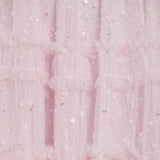
SCATTERED ARTWORK
We carefully consider the placement of our expertly hand-drawn artworks to allow the motifs to delicately scatter towards the hem. This enables the length of each garment to be easily altered without compromising the overall design.

FULL SKIRT ARTWORK
Some of our styles are fully decorated with sequins or embellishment to the hem. On these styles we leave a small amount of undecorated tulle to ensure that the sequins are fully secure. As the embellishment is very dense on these styles, we would not recommend altering the length as this could cause damage to the rest of the embellishment. However, please look on our website as we always offer our dresses in a range of lengths – a full gown length, ankle gown length or ballerina dress length may be more suitable for your height. All dress length measurements can be found on our length guide linked here.
HOW TO STORE YOUR TULLE, EMBELLISHED OR EMBROIDERED PRODUCT
We recommend storing your product gently folded to ensure that the fit is not distorted. Some of our dresses can be very heavy and when hung, the tulle can stretch. We recommend storing your dress in the box to protect it and preserve its beauty.
HOW TO CLEAN YOUR TULLE, EMBELLISHED OR EMBROIDERED PRODUCT

DRY CLEAN ONLY
We recommend that our tulle dresses are dry clean only due to the delicate nature of the embellishment and fabrics. This helps to maintain the quality of your garment and can extend its lifespan. We recommend using a reputable dry cleaner, preferably one who offers more responsible, eco-friendly services.
If you wish to freshen up your dress between wears, we recommend spot cleaning areas with lukewarm water. Try to pat the area rather than rub so that no damage is caused to the surface decoration.

IRONING
If your dress becomes creased, we recommend hanging it for a few days before your event using the hanging loops provided to allow the creases to fall out. We also recommend a light steam or a cool iron on the reverse.
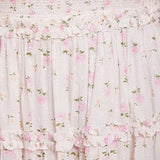
COTTON
We regularly use a lightweight cotton fabric, lined with a cotton voile. Both qualities are made from organic cotton and are certified under the Global Organic Textile Standard (GOTS).
COTTON

HOW TO ALTER YOUR COTTON PRODUCT
Our cotton products are finished with a simple pin hem. An experienced seamstress would be able to easily amend these styles.
HOW TO STORE YOUR COTTON PRODUCT
Your cotton product can be stored hanging or gently folded. If hanging, we recommend using the hanging loops provided to support the weight of the dress.
HOW TO CLEAN YOUR COTTON PRODUCT

DRY CLEAN ONLY
We recommend our cotton dresses are dry clean only due to the delicate nature of the fabric. This helps to maintain the quality of your garment and can extend its lifespan. We recommend using a reputable dry cleaner, preferably one who offers more responsible, eco-friendly services.
If you wish to freshen up your dress between wears, we recommend spot cleaning areas with lukewarm water. Try to pat the area rather than rub so that no damage is caused fabric.

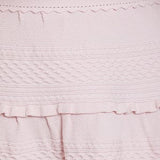
KNITTED DRESSES
We design our knitted dresses with premium yarns to ensure the best possible fit for each style. Our knitted dresses are made from a blend of viscose, nylon and elastane. We use recycled viscose for most of our knitted dresses, which is certified under the Recycled Claim Standard (RCS).
KNITTED DRESSES

HOW TO ALTER YOUR KNITTED DRESS
Due to the construction of the knit, any alterations would cause damage to the garment and therefore we do not recommend to alter these styles.
HOW TO STORE YOUR KNITTED DRESS
Due to the weight of your knitwear dress, we recommend storing your garment gently folded, rather than hanging. Hanging can distort the shape and cause the dress to grow in length.
HOW TO WASH YOUR KNITTED DRESS
Our knitwear dresses can be washed using a cool hand wash. Due to the delicate nature of our garments, we would not recommend to put your garments in the washing machine as this process can cause damage to your garment by shrinking or distorting the fit.

COOL HAND WASH
- Wash in lukewarm water (20° maximum).
- Wash with a small amount of detergent only. Be sparing with the amount of detergent. Do not use
fabric softeners as these will damage the yarn.
- Gently soak your garment without pulling or rubbing.
- Rinse gently, avoiding any twisting or distorting.
- We recommend rolling your knitwear dress in a towel and press gently to remove excess water before drying.
- We recommend drying your knitwear dress flat. Avoid applying heat to your garment or placing in direct sunlight.
- Ensure your garment is fully dried before folding and putting away, to avoid any mould.

IRONING
Knitwear can be cool ironed to remove any creases. Iron the garment on the reverse on the lowest iron setting. We would recommend placing a clean, dry cloth between the iron and your garment to prevent any damage.
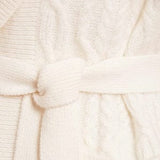
KNITTED JUMPERS & CARDIGANS
We use a range of luxurious yarns within our knitwear collections, combining different stitches to create beautiful detailing. We only source wool that is non-mulesed. We are committed to making our knitwear more responsibly sourced and continue to source more sustainable yarns.
KNITTED JUMPERS & CARDIGANS

HOW TO STORE YOUR KNITWEAR
We recommend storing your knitwear product gently folded, rather than hanging. Hanging knitwear can distort the shape.
HOW TO WASH YOUR KNITWEAR
Different yarns require different methods of washing, we therefore highly recommend checking the wash care label before cleaning your garments. We would not recommend putting your garments in the washing machine as this process can cause damage to your garment by shrinking, pilling or distorting the fit.

DRY CLEAN ONLY
Some of our knitwear is dry clean only due to the delicate nature of the yarn. This helps to maintain the quality of your garment and can extend its lifespan. We would recommend that a garment would only need cleaning once or twice per season. We recommend using a reputable dry cleaner, preferably that can offer eco-friendly services.

COOL HAND WASH
Some of our knitwear can be washed by hand, following the below recommended instructions:
- Wash in lukewarm water (20° maximum).
- Wash with a small amount of detergent only. Be sparing with the amount of detergent as this can cause felting. Do not use fabric softeners as these will damage the yarn.
- Gently soak your garment without pulling or rubbing.
- Rinse gently, avoiding any twisting or distorting.
- We recommend rolling your knitwear in a towel and pressing gently to remove excess water before drying.
- We recommend drying your knitwear flat. Avoid applying heat to your garment or placing it in direct sunlight.
- Ensure your garment is fully dried before folding and putting away, to avoid any mould.

IRONING
Knitwear can be gently cool ironed to remove any creases. Iron the garment on the reverse on the lowest iron setting. Do not press or crush the knit.
HOW TO MAINTAIN YOUR KNITWEAR
As wool is a natural fibre, the yarn can have tendencies that need to be maintained.
PILLING
Pilling is a natural occurrence that happens on all natural fibres. To remove pilling, we recommend using a pill comb. Lay your garment flat and gently run the comb in the same direction over the affected areas on the garment.
SHEDDING
Shedding of fibres is also a natural occurrence. If your garment is shedding too many fibres, washing your garment following the washing instructions should help to remove them. It is common that your garment may shed more fibres before its first wash.
FELTING
Felting can occur when wet woollen fibres rub together. Excess detergent used when washing can encourage rubbing and result in felting. Therefore, we recommend using a small amount of detergent when washing your garment. Fabric softeners should not be used at all in the washing process as this can damage the fibres of the yarn.


